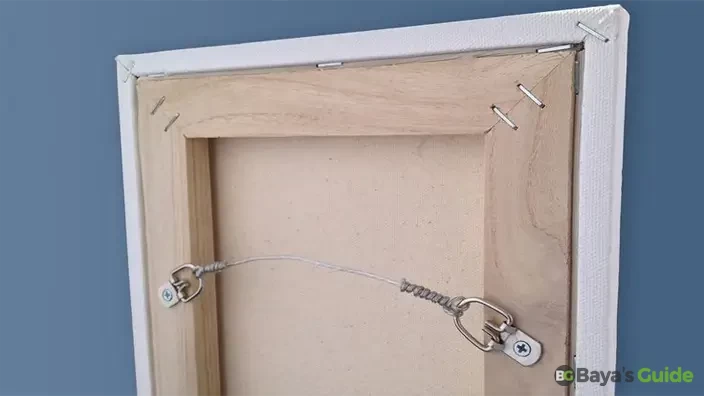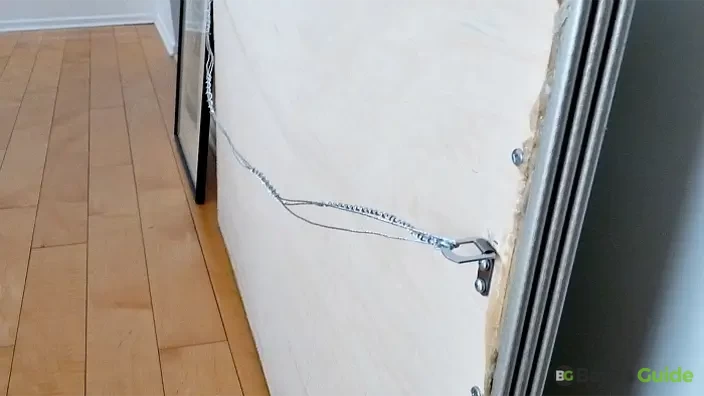Beware of the process of hanging a picture that may seem simple, but achieving an aesthetically pleasing and secure display requires a thoughtful approach. Whether you're a seasoned decorator or a novice looking to adorn your space with cherished memories or captivating artwork, the art of picture hanging involves more than just placing a nail on the wall.
Begin your picture-hanging journey by delving into the essential considerations that contribute to a successful display. From understanding wall types and selecting appropriate hardware to exploring creative arrangements, we'll navigate the nuances that transform a mere picture on a wall into a visually captivating focal point. Whether you're seeking a gallery-worthy arrangement or a simple, elegant display, this guide will empower you to hang your pictures with confidence, ensuring they become captivating elements that enhance the overall ambiance of your home or workspace.
In this guide, we'll explore the step-by-step process, from selecting the right hardware and tools to ensuring proper placement and alignment. Mastering the art of picture hanging not only elevates the visual appeal of your space but also ensures your beloved pieces are showcased securely and with precision.
Table of Contents
Drywall Picture Hanging: Understanding Weight Restrictions
The weight of a picture can be on drywall depending on the strength of the wall and the type of hanging hardware used. As a general guideline, standard picture hangers and nails can typically support pictures up to 10 pounds on drywall. For heavier items, it's advisable to use specific drywall anchors or screws designed to distribute weight more evenly and provide additional support.
For larger and heavier pictures or artwork, consider using wall anchors, screws, or even a wall stud for added stability. Wall studs offer the strongest support, and locating them with a stud finder can ensure secure hanging for heavier items. Always check the manufacturer's guidelines for any hanging hardware or anchors you use and consider consulting with a professional if you need clarification on the weight-bearing capacity of your drywall or the appropriate hanging method for your specific item.
Must-Have Supplies for Wall Picture Mounting
To hang a picture on a wall, you'll need the following supplies:
- Picture OR Artwork - The item you want to hang.
- Picture Hanger OR Wire - Depending on the type of frame, use a picture hanger or wire for hanging.
- Hooks, Nails, OR Screws - Choose appropriate hooks, nails, or screws based on the weight and size of the picture.
- Wall Anchors - If you're not able to secure the picture to a wall stud, use wall anchors for added support, especially for heavy items.
- Level - A level ensures that your picture hangs straight. It's essential for achieving a visually appealing display.
- Tape Measure - Measure the wall space and distances for accurate placement of the picture.
- Pencil - Use a pencil to mark the spots where you'll be drilling or hammering.
- Stud Finder - A stud finder helps locate wall studs, providing secure anchor points for heavier items.
- Drill OR Hammer - Depending on your preference and the wall type, use a drill or hammer to insert screws, nails, or wall anchors.
- Screwdriver - Use a screwdriver to secure screws or wall anchors in place.
- Wall Patch (Optional) - If you make any holes in the wall, have wall patching material on hand to fill and repair holes if needed.
- Soft Cloth OR Towel (Optional) - Place a soft cloth or towel under your work area to catch any dust or debris.
Prior Tip: Having these supplies ready ensures a smooth and efficient process when hanging pictures on your wall. Adjust the type and size of the hardware based on the characteristics of your wall and the weight of the picture. Always follow safety guidelines and manufacturer recommendations for the specific hanging hardware you choose.
Essential Considerations For Heavy Picture Mounting
Though hanging pictures on the plaster walls seems and sounds very easy various factors are backing the process of hanging a heavy picture and making it an artwork. Not only the picture, but you can also hang any decorative item or a heavier frame in this way. Multiple techniques are working in it that may include the following:
1- Assessing Your Picture's Weight
Before you plan to hang a picture at the exact point with accurate form, you need to weigh the object first with a bathroom scale. If your picture is lighter in weight, the hanging solutions will be easier without nails. Remember, if your picture is weightier than 10 pounds, you should read the article given below on how to fix it with a rail track or wall stud.
As a general rule, this is the weight of your picture which will determine the techniques and methods you can use to fix a picture. You need a specific kind of material that can carry the frame and mirror if your picture is heavier.
Picture with 10lbs examines the light load, 10-25lbs depicts the medium stuff rather 25-50lbs are considered the heaviest load. Measure the point on the wall and check the package before you go on to fasten the picture on the wall.
2- Evaluating Your Wall
If you look before the1940s, in earlier times, most walls were usually made of plasters but on the contrary, the modern are of drywall. That’s why the walls of bricks, ceramic tiles, or mortar can bear the weight of a picture and the hit of a hammer and other necessary tools.
3- Optimal Placement For Hanging
Select the desired location for hanging your picture. Consider factors such as eye level, the overall aesthetic of the room, and any furniture arrangements.
4- Use A Level
Place a level horizontally or vertically to ensure the picture will hang straight. Adjust the position until the level indicates that it's perfectly aligned.
5- Precise Positioning: Marking The Top Center
Before drilling and hanging your picture on the wall, precision in marking is crucial for achieving a well-aligned and visually appealing display. Begin by selecting the ideal location and using a level to ensure the picture will hang straight. Mark the top center point on the wall where the hanging hardware will be placed. Measure the distance from this mark to where the hardware will attach, then transfer these measurements to the back of the picture frame. Align the frame with the level, mark the precise spots on the wall where screws or nails will go, and double-check their alignment.
Once confident in the positioning, drill pilot holes at the marked spots, insert anchors if necessary, and attach the hanging hardware securely. This meticulous marking process ensures accuracy and enhances the overall aesthetics of your wall display.
6- Mark Hole Locations
Holding the picture against the wall in the desired position, make small marks at the points where the screws or nails will go. Use a pencil to create visible marks.
Suggested Post:How To Dress Newborn In Summer
Hanging A Picture on Drywall & Plaster
Hanging a picture on drywall and plaster requires a thoughtful approach to ensure stability and an aesthetically pleasing display. When dealing with drywall, it's crucial to locate the wall studs for maximum support. Use a stud finder to identify these sturdy vertical structures behind the drywall. Once located, position your picture hangers or screws to align with the studs, distributing the weight evenly.
If your picture is heavy, consider using wall anchors designed for drywall to enhance support. For plaster walls, which are more solid and dense, pre-drill small pilot holes using a masonry bit. Insert wall anchors into these holes to provide a secure foundation for your hanging hardware.
Regardless of the wall type, always use appropriate hanging hardware such as picture hooks, screws, or nails, depending on the weight of the picture. Take advantage of levels to ensure your picture hangs straight and aligns with the overall aesthetics of the space. Measure and mark carefully before drilling to avoid unnecessary holes and ensure accurate placement.
1- Hit Traditional Picture Cliffs
Most people are completely unaware of traditional picture hangers which can make the pictures sturdy without damaging the wall. If you have softened the hangers, that can bear the picture weight up to 25 lbs. and with just two nails, it can carry 50 lbs. picture. Remember, for medium-sized paintings, measure the limits of cliffs on plaster walls. It doesn’t damage the plaster wall even when you are using screws and anchor screws. After deciding the point in the wall, hammer the picture hangers fix the nails over them, and then hang the picture.
2- Fix Anchor Bolts
There is a huge variety of anchor bolts as per the size and weight of the picture available in the hardware store. Your first task after marking the wall is to drill pilot holes and then insert the screws in the plaster walls. Avoid using hammers and nails directly in the plaster walls may damage it.
The fact you need to know, plastic anchor screws are considered safe on plaster walls for several reasons. Plaster walls, being denser than drywall, require a secure anchoring method to support hanging items. Plastic anchors, typically made from materials like nylon or plastic, are suitable for plaster walls for the following reasons:
- Plastic anchors are designed to gently expand within the drilled hole as the screw is inserted. This controlled expansion helps create a snug fit within the plaster, providing stability without causing undue stress or cracks.
- Plaster walls are more prone to cracking compared to drywall. Plastic anchors exert less pressure during installation, reducing the risk of creating additional cracks or damage to the plaster.
- Plastic anchors are versatile and available in various sizes to accommodate different weights and sizes of hanging items. This adaptability allows users to choose an anchor suitable for the specific requirements of their pictures or decorations.
- Plastic anchors are resistant to corrosion, which is beneficial for preserving the integrity of the anchor over time. Plaster walls may be more sensitive to metal anchors that could corrode and compromise their effectiveness.
- Plastic anchors are generally easy to install, making them user-friendly for DIY enthusiasts. The simplicity of installation contributes to a smoother process when hanging items on plaster walls.
- While plastic anchors are generally safe for plaster walls, it's crucial to select the appropriate anchor size based on the weight of the item being hung. Following the manufacturer's guidelines and ensuring proper installation will contribute to a secure and damage-free hanging experience on plaster walls.
3- Reliable Solutions For Weighty Wall Hangings
Toggle bolts are the rods that can carry the object with the heaviest weight and arespring-loaded to support the pictures from the wall sides. These toggle bolts fit to plaster walls but there you need a wider drill to make the holes. Insert the spring-loaded wings in the holes after folding them. Set the picture hanger on it and hang the picture directly on the screws.
Common Mistakes To Avoid When Hanging Pictures
When hanging a picture on a plaster wall, there are certain practices you should omit to prevent damage and ensure a secure installation:
1- Avoid Hammering Without Pre-Drilling
Do not hammer nails directly into the plaster without pre-drilling. Plaster walls are more prone to cracking, and pre-drilling helps minimize the risk by creating a guide for the nail or anchor.
2- Avoid Heavy-Duty Anchors Without Studs
Avoid using heavy-duty anchors or screws without locating and anchoring to wall studs. Plaster walls benefit from the additional support provided by studs, especially when dealing with heavier items.
3- Don't Skip Stud Finding
Never skip using a stud finder to locate wall studs. Hanging solely on plaster without securing studs may compromise the stability of the installation.
4- Avoid Overloading Weak Points
Avoid overloading weak points in the plaster, such as areas around corners, edges, or large cracks. Distribute the weight of your hanging items evenly across the wall.
5- Don't Ignore Weight Limits
Do not ignore weight limits specified by the hanging hardware or anchors. Exceeding these limits may lead to failure and potential damage to the plaster wall.
6- Avoid Using Incorrect Anchors
Avoid using anchors that are not suitable for plaster walls. Choose anchors specifically designed for plaster to ensure proper support and minimize the risk of damage.
7- Ensure Proper Hanging Clearances
Do not hang pictures too close to heat sources or in areas prone to moisture, as these conditions can impact the integrity of the plaster over time.
8- Consider Wall Surface Condition
Avoid hanging items on plaster that are in poor condition, such as areas with extensive cracks or significant deterioration. Repair and stabilize the plaster before hanging anything.
By omitting these practices, you enhance the chances of a successful and damage-free picture-hanging experience on plaster walls. Always follow recommended guidelines, use appropriate anchors, and consider consulting a professional if unsure about the condition of the plaster or the appropriate hanging method.
Frequently Asked Questions
What Factors Contribute To The Weight Of Heavy Frames?
Estimating the weight of heavy frames involves considering various factors like frame material, size, and design. Common types include oil paintings, wooden frames, acrylic paintings, metal frames, art pieces, antique frames, picture frames, custom or oversized frames, signage, headboards, mirrors, panels, whiteboards, and shelving. Keep in mind that these are general estimates, and actual weights may vary. It's advisable to consult with the manufacturer or seller for precise specifications. When hanging heavy frames, ensure to use suitable anchors, screws, or hanging hardware, and consider your wall's weight-bearing capacity and anchor type.
How Heavy Can A Picture Be To Hang On Drywall?
If you are using simple nails, then the weight of the object you are going to hang should be less than 20 pounds. Wall Mounted Coated Hooks are great to handle and hold objects heavier than 50 pounds. On the other hand, drywall screws are strong enough to hold the object equivalent to 20 pounds.
How Can I Hang Heavy Objects On A Wall Without Drilling?
Hanging a heavy object on a wall without drilling typically involves using alternative hanging methods that distribute the weight across a larger area. Here are a few options:
- Heavy-duty adhesive hooks are designed to hold significant weight. Clean the wall surface, apply the adhesive hook following the manufacturer's instructions, and wait for it to set before hanging your object.
- Similar to hooks, adhesive strips are designed for heavy items. These strips adhere to both the object and the wall, creating a strong bond without the need for drilling.
- Some heavy-duty mounting tapes are specifically designed for hanging items without drilling. Ensure the tape is suitable for the weight of your object.
- Tension rods can be used for hanging lightweight to moderately heavy items. Adjust the tension rod to fit the width of the space and hang your object from it.
- If your wall has decorative molding or trim, you may be able to hang heavy objects directly from these features without drilling into the wall itself.
- For heavy items like mirrors or artwork, consider placing freestanding shelves or furniture beneath and leaning the object against the wall.
What Can I Use To Hang A Heavy Picture Frame?
In case you are going to hold the heavy item, you can use a metal molly bolt is to be taken as the best bet. As they are made of strong metal of large size have the potential to carry 50 pounds. These bolts are also helpful in removing the screw and anchor from the wall easily.
How Much Weight Can Drywall Hold?
The weight drywall can hold depends on various factors, including the thickness and quality of the drywall, the size and type of anchor or fastener used, and whether the weight is distributed evenly across the wall. As a general guideline:
- Standard 1/2-inch or 5/8-inch-thick drywall can typically support around 5 to 10 pounds per square foot. This estimate considers an evenly distributed load.
- If you're able to anchor your hanging item to a wall stud, the weight capacity significantly increases. Wall studs can support heavier loads than the drywall alone.
- The type of anchors or fasteners used also influences weight capacity. Heavy-duty anchors designed for drywall can handle greater weights compared to basic nails or screws.
- Distributing the weight across a larger area can increase the overall weight capacity. For example, using a wide shelf or a piece of furniture can disperse the load more effectively.
Conclusion
In conclusion, mastering the art of hanging heavy pictures entails understanding various factors such as the weight of the frame, the type of wall, and the appropriate hanging hardware. By considering these elements and following proper techniques, you can ensure a secure and visually appealing display of your cherished artwork or decor. Remember to weigh your frames, assess your wall type, choose suitable locations, and avoid common mistakes to achieve a successful installation. Whether you're enhancing your living space or showcasing valuable pieces, a thoughtful approach to hanging heavy pictures can elevate the aesthetic appeal of any room while ensuring stability and safety.






















